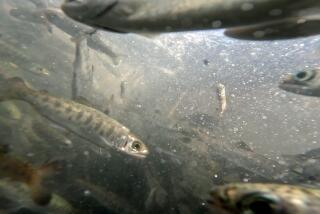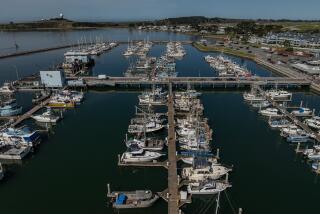The Copper River salmon craze: How the race began

- Share via
It’s been 30 years since Jon Rowley first persuaded a few salmon fishermen on Alaska’s Copper River that they might be able to do something with their superb fish other than sell it to the cannery. But even he never guessed things would get this crazy.
Today, Copper River salmon is a smash hit. And at the root of this success are a couple of big ideas, one that seems obvious today -- getting the best fish and handling them carefully -- and one that is still a bit wacky -- a race to see which restaurant could serve the first Copper River king salmon of the season
As the Copper River season begins Wednesday, these fish will be one of the few name-dropped on menus. And the first fresh Copper River salmon of the season could fetch as much as $50 a pound.
But 30 years ago, almost none of the fish was even sold fresh. When food marketing guru Jon Rowley offered the fishermen $3.50 a pound, they were overjoyed.
RECIPES: Nine great salmon recipes
Rowley, who was consulting with Seattle-area restaurants about fish, learned about the salmon from Seattle smokehouse owner Erling Nilson, who was buying the fish frozen. When Rowley investigated further, he found that not only was the fish superb, but also the port was less than a mile from an airport, which would allow quick shipping.
“They had the airport, they had a name you just couldn’t improve on, and they had the first major run of fresh salmon from the Northwest,” Rowley says.
But even more importantly, these fish were genetically a cut above.
“The fish have these superior genetics, they just put on a lot of oil,” he said. “Copper River is not a long river — it’s only 300 miles or so — but there are some really tumultuous rapids. The fish develop this oil so they can power up through there. That’s what makes good eating.
“They had all of these advantages, but nobody was marketing the fish fresh, it was all going to canning.”
Of course, there was more to creating the Copper River craze than just slapping a fancy tag on a fat fillet. First, Rowley had to teach the fishermen how to take care of their catch.
“You know when I first talked to a small group of fishermen to try to get some interest in going to fresh market,” Rowley says, “they said there was just no way they could do it.”
High-quality fish requires special handling — they need to be caught alive, bled immediately and iced before rigor mortis can set in. The canning boats weren’t set up for the amount of work that was required.
But one fisherman took the bait.
“About a month out from the season opening,” he said, “a fisherman named Tommy Johnson said he was ready to give it a try. I basically had to educate him how to do all this stuff — just basic things like not letting the fish die in the nets.
“I told Tommy that when the fish come into the restaurant, they needed to have that immediate perception of value. They had to have that kind of luminous quality, so when they open the box, they say, ‘Wow, look at that fish!’ ”
Rowley personally delivered hundreds of pounds of the fresh fish to some restaurant clients in the Seattle area.
“I brought down 400 pounds and delivered it myself to each restaurant,” he says. “I spent some time in each kitchen showing them the fish and telling the story. We’d cut some fillets and when you run your hand down the side it would be coated with this beautiful orange salmon oil. Then the fish went out into the restaurant and right away waiters were coming back saying their customers told them it was the best salmon they’d ever eaten.”
To top it off, Rowley came up with a crazy marketing trick: He started a race to see which restaurant could serve the first Copper River king salmon of the season, a tradition that continues.
“At first, I was the only one in the race but nobody knew that,” Rowley said.
“I’d pick up the salmon from the boat and send out these regular dispatches. And we’d have TV crews, radio reporters, everybody, would come out and cover the arrival of the first Copper River king salmon.
“Every year it got to be more important. One year President Clinton was in town speaking and there were more TV cameras at the airport covering the first salmon arriving than were covering the president.
“Sometimes the goofier the idea, the better it works.”
ALSO:
Are you ready for the waffle taco?
Vartan Abgaryan on fava hummus and ramps galore
More to Read
Eat your way across L.A.
Get our weekly Tasting Notes newsletter for reviews, news and more.
You may occasionally receive promotional content from the Los Angeles Times.











